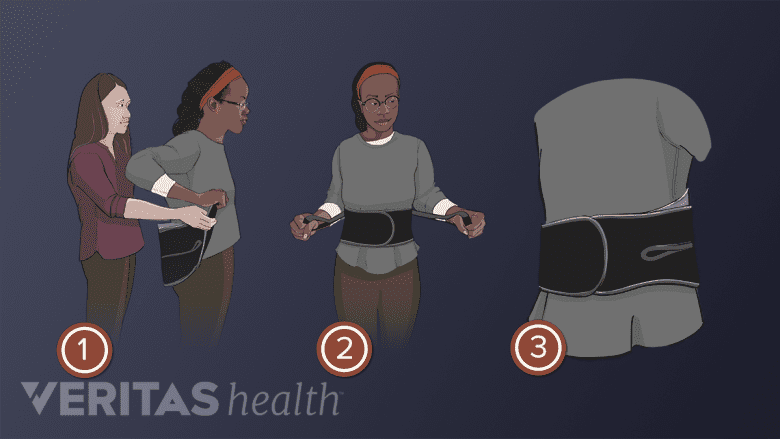A prescription back brace should come with instructions on use and maintenance from the doctor, the brace manufacturer, or both. These instructions may include information on fitting the brace, putting on and taking off the brace, and cleaning and taking care of the brace.
It is important to wear a back brace according to the instructions provided with the brace and/or advised by the prescribing doctor. Many braces are fitted specially for the patient’s needs and body, and if worn incorrectly can cause further injury and worsened pain.
In This Article:
- Using a Back Brace for Lower Back Pain Relief
- Types of Back Braces Used for Lower Back Pain Relief
- When to Consider a Back Brace
- How to Use and Wear a Lower Back Brace
Wearing A Back Brace

Most braces are put on by following a few general steps:
- Wrap the brace around the back with the wings against either side of the torso.Reaching to wrap the brace behind the body can be difficult with a painful back, and enlisting help from a partner or friend may be advisable.
- Make more precise adjustments to the tightness and pressure in the brace; typically, small adjustments are made using two pull tabs on either side of the brace
- Connect the two ends across the abdomen
Pain while putting on the brace can also be avoided by first setting the brace in a chair with the wings open so that when sitting, the wings are on either side of the body. Then, holding on to the wings, stand up and secure the front of the brace.
Wearing a shirt under the brace is usually needed to minimize skin irritation. Some doctors may even recommend or provide shirts that work best. In general, a shirt that is fitted and made of soft cotton fabric will prevent irritation. A baggy shirt may aggravate the skin.
Brace Cleanliness and Hygiene
Regular cleaning for both the brace and the skin can help prevent skin rashes or lesions. If significant skin irritation occurs, it may be necessary to stop wearing the brace for several days while the skin heals.
Skin care
Wearing a back brace improperly can aggravate the skin, causing sores or rashes to develop. Washing the skin under the brace each day will help keep dirt and dead skin from building up and causing irritation.
Too much moisture under the brace can irritate the skin and potentially lead to sores and/or skin deterioration. For this reason, avoid wearing lotions or moisturizers under the brace.
It is common to have some red spots on the skin after taking the brace off. These spots should go away within 15 to 30 minutes. If they do not go away, or the brace leaves a rash or bruise on the skin, the brace may not be fitted properly and should be adjusted by a doctor or specialist.
Cleaning the brace
Specific washing instructions are usually provided by the brace manufacturer, and should be followed to preserve the brace’s longevity and effectiveness.
Most back braces are not designed to be machine washed or dried—it is generally advised to hand wash the brace using water and a mild soap. Any additional padding or panels should be removed first and washed separately. A brace should be laid flat or hung to dry.
Make sure the brace is rinsed thoroughly and dried completely before wearing, as a soapy or wet brace is more likely to irritate skin. It can also be a good idea to remove any dirt, dust, or debris on the brace by using a lint roller.

